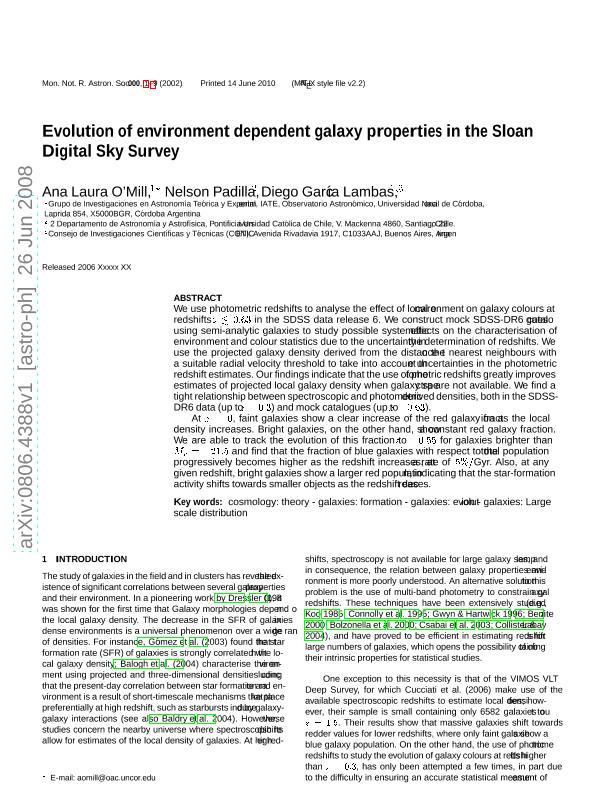Artículo
Radio galaxies in the sloan digital sky survey: Spectral index-environment correlations
Bornancini, Carlos Guillermo ; O'Mill, Ana Laura
; O'Mill, Ana Laura ; Gurovich, Sebastian
; Gurovich, Sebastian ; Garcia Lambas, Diego Rodolfo
; Garcia Lambas, Diego Rodolfo
 ; O'Mill, Ana Laura
; O'Mill, Ana Laura ; Gurovich, Sebastian
; Gurovich, Sebastian ; Garcia Lambas, Diego Rodolfo
; Garcia Lambas, Diego Rodolfo
Fecha de publicación:
07/2010
Editorial:
Wiley Blackwell Publishing, Inc
Revista:
Monthly Notices of the Royal Astronomical Society
ISSN:
0035-8711
e-ISSN:
1365-2966
Idioma:
Inglés
Tipo de recurso:
Artículo publicado
Clasificación temática:
Resumen
We analyse optical and radio properties of radio galaxies detected in the Sloan Digital Sky Survey. The sample of radio sources is selected from the catalogue of Kimball & Ivezić with flux densities at 325, 1400 and 4850 MHz, using Westerbork Northern Sky Survey, NRAO VLA Sky Survey and Green Bank 6 cm radio surveys and from flux measurements at 74 MHz taken from Very Large Array Low-Frequency Sky Survey (Cohen et al. 2006). We study radio galaxy spectral properties using radio colour-colour diagrams and find that our sample follows a single power law from 74 to 4850 MHz. The spectral index versus spectroscopic redshift relation is not significant for our sample of radio sources. We analyse a subsample of radio sources associated with clusters of galaxies identified from the maxBCG catalogue and find that about 40 per cent of radio sources with ultrasteep spectra (USS; where ) are associated with galaxy clusters or groups of galaxies. We construct a Hubble diagram of USS radio sources in the optical r band up to and compare our results with those for normal galaxies selected from different optical surveys and find that USS radio sources are around as luminous as the central galaxies in the maxBCG cluster sample and typically more than 4 mag brighter than normal galaxies at We study correlations between spectral index, richness and luminosity of clusters associated with radio sources. We find that USS at low redshift are rare, most of them reside in regions of unusually high ambient density, such of those found in rich cluster of galaxies. Our results also suggest that clusters of galaxies associated with steeper than the average spectra have higher richness counts and are populated by luminous galaxies in comparison with those environments associated to radio sources with flatter than the average spectra. A plausible explanation for our results is that radio emission is more pressure confined in higher gas density environments such as those found in rich clusters of galaxies and as a consequence radio lobes in rich galaxy clusters will expand adiabatically and lose energy via synchrotron and inverse Compton losses, resulting in a steeper radio spectra.
Archivos asociados
Licencia
Identificadores
Colecciones
Articulos(CCT - CORDOBA)
Articulos de CTRO.CIENTIFICO TECNOL.CONICET - CORDOBA
Articulos de CTRO.CIENTIFICO TECNOL.CONICET - CORDOBA
Articulos(IATE)
Articulos de INST.DE ASTRONOMIA TEORICA Y EXPERIMENTAL
Articulos de INST.DE ASTRONOMIA TEORICA Y EXPERIMENTAL
Citación
Bornancini, Carlos Guillermo; O'Mill, Ana Laura; Gurovich, Sebastian; Garcia Lambas, Diego Rodolfo; Radio galaxies in the sloan digital sky survey: Spectral index-environment correlations; Wiley Blackwell Publishing, Inc; Monthly Notices of the Royal Astronomical Society; 406; 1; 7-2010; 197-207
Compartir
Altmétricas



